|
News
We Told You So: LB Gets Spectacular View of Missile Defense Shield Test; See Our Pix
Pentagon says test successful, target missile and mock warhead (seen in pix) intercepted more than 140 miles above earth
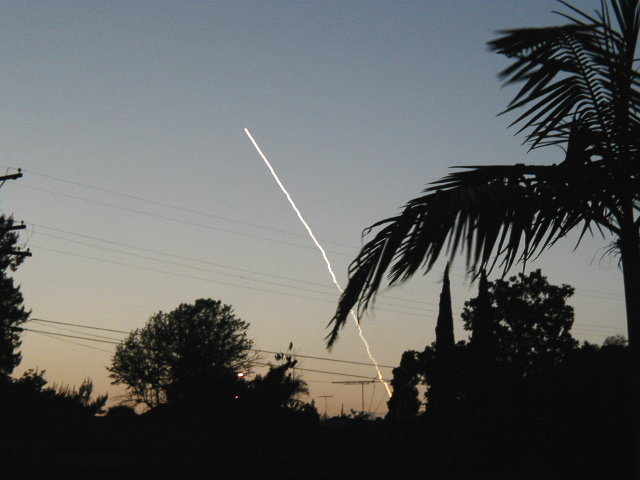 (March 15, 2002, web posted at 7:45 p.m., updated 9:00 p.m.) -- As LBReport.com reported in an article posted this morning, LB got a spectacular view of a missile defense system test shortly after sunset today. (March 15, 2002, web posted at 7:45 p.m., updated 9:00 p.m.) -- As LBReport.com reported in an article posted this morning, LB got a spectacular view of a missile defense system test shortly after sunset today.
[8:55 p.m. update] The Pentagon says the test was successful, and an interceptor missile, launched from Kwajalein Atoll in the Marshall Islands, hit the ascending mock warhead launched from Vandenberg AFB (and seen in these pictures) at an altitude in excess of 140 miles above the earth during the midcourse phase of the target warhead's flight. [Verbatim Dept. of Defense release follows pictures.]
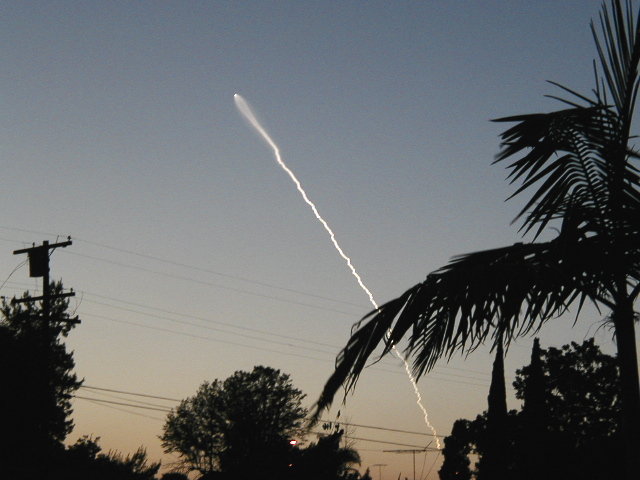 At roughly 6:11 p.m., a brilliant white plume streaked from the horizon toward the sky in the west/northwest at terrific speed. We grabbed our digital camera and started shooting. At roughly 6:11 p.m., a brilliant white plume streaked from the horizon toward the sky in the west/northwest at terrific speed. We grabbed our digital camera and started shooting.
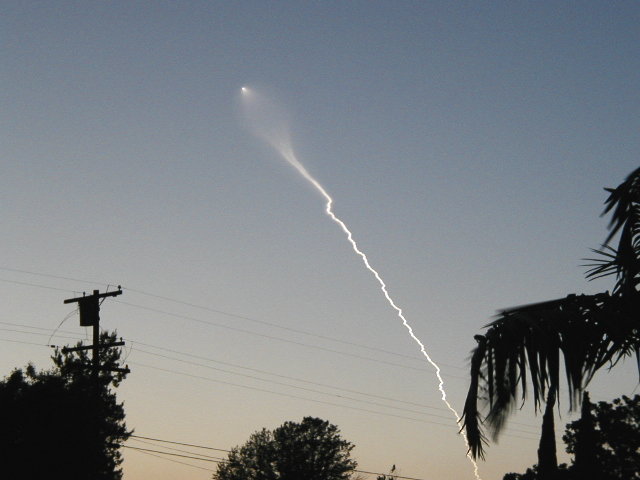 The pictures on this page were taken by us from the Los Cerritos area at the Wardlow Road/Pacific Avenue Blue Line station (where we happened to be dropping someone off). The pictures on this page were taken by us from the Los Cerritos area at the Wardlow Road/Pacific Avenue Blue Line station (where we happened to be dropping someone off).
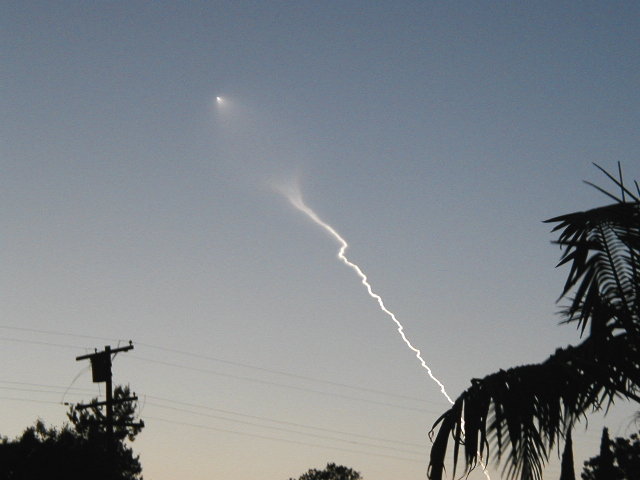 The missile, launched from Vandenberg AFB, carried the target: a mock warhead and balloon decoys. The missile, launched from Vandenberg AFB, carried the target: a mock warhead and balloon decoys.
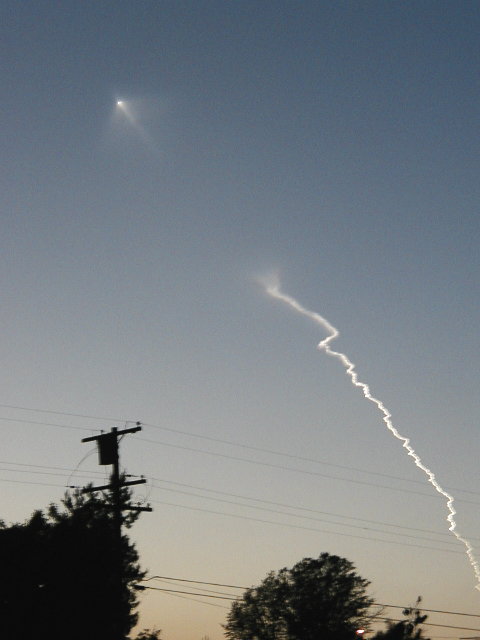 Meanwhile, from distant Kwajalein Atoll in the Marshall Islands, an interceptor missile was launched. The defensive missile from Kwajalein targeted the Vandenberg target mock warhead as it ascended at an altitude of over 140 miles above the earth. Meanwhile, from distant Kwajalein Atoll in the Marshall Islands, an interceptor missile was launched. The defensive missile from Kwajalein targeted the Vandenberg target mock warhead as it ascended at an altitude of over 140 miles above the earth.
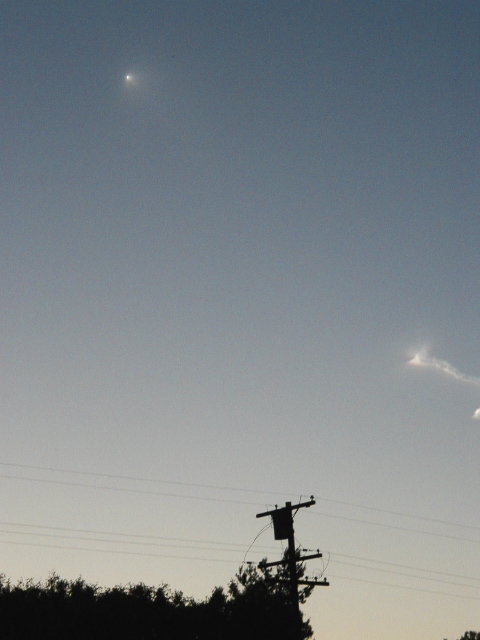 The launch is part of testing being conducted on a missile defense system that may one day protect the U.S. homeland from an incoming weapon of mass destruction. The launch is part of testing being conducted on a missile defense system that may one day protect the U.S. homeland from an incoming weapon of mass destruction.
Backlit in the post sunset glow, the photos speak for themselves. Bright spot appears to include payload with mock warhead
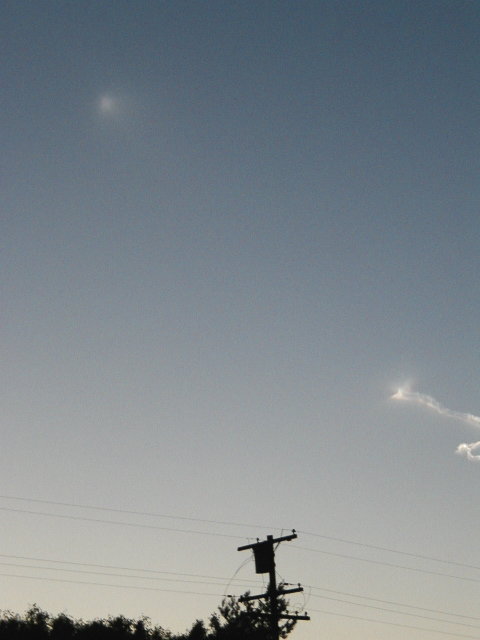 The target payload, a brilliant spot in early photos, grows fuzzy... The target payload, a brilliant spot in early photos, grows fuzzy...
 ...then disappears (leaving only missile contrail, far right.) Based on the chronology in the DOD press release, the intercept occurred at roughly 6:40 p.m. (about 20 minutes after our final picture was taken.) ...then disappears (leaving only missile contrail, far right.) Based on the chronology in the DOD press release, the intercept occurred at roughly 6:40 p.m. (about 20 minutes after our final picture was taken.)
Less than three hours later, the Pentagon announced the test was successful. We post the Dept. of Defense release verbatim:
The Missile Defense Agency (MDA) announced today it has successfully completed a test involving a planned intercept of an intercontinental ballistic missile target.
The test took place over the central Pacific Ocean. A modified Minuteman intercontinental ballistic missile (ICBM) target vehicle was launched from Vandenberg Air Force Base, Calif., at 9:11 p.m. EST, and a prototype interceptor was launched approximately 20 minutes later and 4,800 miles away from the Ronald Reagan Missile Site, Kwajalein Atoll, in the Republic of the Marshall Islands.
The intercept took place approximately 10 minutes after the interceptor was launched, at an altitude in excess of 140 miles above the earth and during the midcourse phase of the target warhead's flight. This was the fourth successful intercept for the Ground-based Midcourse Defense (GMD) Segment, formerly known as National Missile Defense.
The test successfully demonstrated exoatmospheric kill vehicle (EKV) flight performance and "hit to kill" technology to intercept and destroy a long-range ballistic missile target. In addition to the EKV locating, tracking, and intercepting the target resulting in its destruction using only the body-to-body impact, this test also demonstrated the ability of system elements to work together as an integrated system.
The test involved the successful integrated operation of space and ground-based sensors and radars, as well as the Battle Management, Command Control and Communications (BMC3) function to detect the launch of the target missile, cue an early warning radar to provide more detailed target location data; and integration of a prototype X-Band radar (based at Kwajalein) to provide precise target data to the EKV, which received the target updates from the In-Flight Interceptor Communications Systems (IFICS) at Kwajalein.
The EKV separated from its rocket booster more than 1,400 miles from the target warhead. After separation, it used its on-board infrared and visual sensors, augmented with the X-Band radar data provided by BMC3 via the In-flight Interceptor Communications System, to locate and track the target. Sensors aboard the EKV also successfully selected the target instead of three balloon decoys. Only system-generated data was used for the intercept after the EKV separated from its booster rocket. A C-band transponder aboard the target warhead did not provide any tracking or targeting information to the interceptor after the interceptor was launched.
Tonight's test is a major step in our aggressive developmental test program, and is the fourth successful intercept in six attempts. We will continue to pursue this testing regime to achieve a layered approach to missile defense, using different architectures to deter the growing threat of ballistic missiles carrying weapons of mass destruction.
Over the next several weeks, government and industry program officials will conduct an extensive analysis of the data received during the flight test to determine whether anomalies or malfunctions occurred during the test, evaluate system performance and determine whether or not all flight test objectives were met. Since the system is in the developmental phase of design and testing, performance of individual elements and the overall system integration was as important as the actual intercept.
|




 (March 15, 2002, web posted at 7:45 p.m., updated 9:00 p.m.) -- As LBReport.com reported in an article posted this morning, LB got a spectacular view of a missile defense system test shortly after sunset today.
(March 15, 2002, web posted at 7:45 p.m., updated 9:00 p.m.) -- As LBReport.com reported in an article posted this morning, LB got a spectacular view of a missile defense system test shortly after sunset today. At roughly 6:11 p.m., a brilliant white plume streaked from the horizon toward the sky in the west/northwest at terrific speed. We grabbed our digital camera and started shooting.
At roughly 6:11 p.m., a brilliant white plume streaked from the horizon toward the sky in the west/northwest at terrific speed. We grabbed our digital camera and started shooting. The pictures on this page were taken by us from the Los Cerritos area at the Wardlow Road/Pacific Avenue Blue Line station (where we happened to be dropping someone off).
The pictures on this page were taken by us from the Los Cerritos area at the Wardlow Road/Pacific Avenue Blue Line station (where we happened to be dropping someone off). The missile, launched from Vandenberg AFB, carried the target: a mock warhead and balloon decoys.
The missile, launched from Vandenberg AFB, carried the target: a mock warhead and balloon decoys. Meanwhile, from distant Kwajalein Atoll in the Marshall Islands, an interceptor missile was launched. The defensive missile from Kwajalein targeted the Vandenberg target mock warhead as it ascended at an altitude of over 140 miles above the earth.
Meanwhile, from distant Kwajalein Atoll in the Marshall Islands, an interceptor missile was launched. The defensive missile from Kwajalein targeted the Vandenberg target mock warhead as it ascended at an altitude of over 140 miles above the earth. The launch is part of testing being conducted on a missile defense system that may one day protect the U.S. homeland from an incoming weapon of mass destruction.
The launch is part of testing being conducted on a missile defense system that may one day protect the U.S. homeland from an incoming weapon of mass destruction.
 The target payload, a brilliant spot in early photos, grows fuzzy...
The target payload, a brilliant spot in early photos, grows fuzzy... ...then disappears (leaving only missile contrail, far right.) Based on the chronology in the DOD press release, the intercept occurred at roughly 6:40 p.m. (about 20 minutes after our final picture was taken.)
...then disappears (leaving only missile contrail, far right.) Based on the chronology in the DOD press release, the intercept occurred at roughly 6:40 p.m. (about 20 minutes after our final picture was taken.)